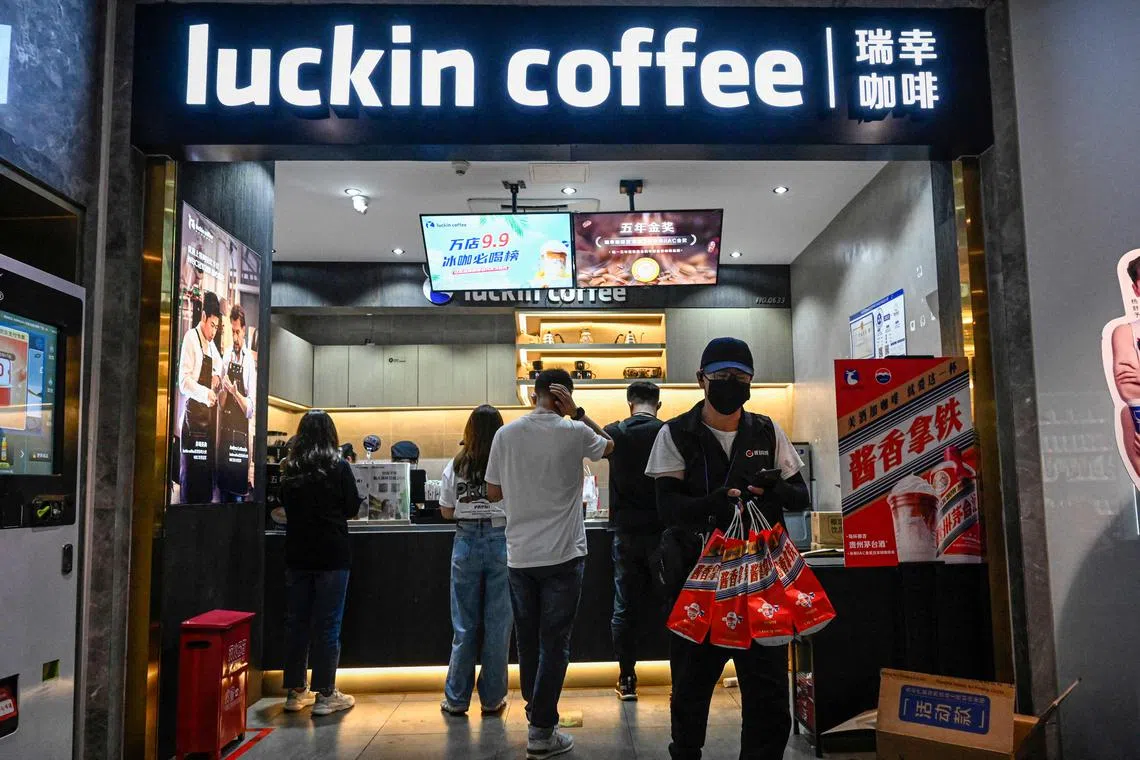‘Downgraded spending’: The shift to thrift in the Chinese economy
Sign up now: Get ST's newsletters delivered to your inbox

The jostling over coffee prices captures an emerging trend among Chinese consumers who are spending less and saving more.
PHOTO: AFP
Follow topic:
SEOUL - To understand today’s penny-pinching Chinese consumers, behold the vicious price war playing out among the country’s coffee store giants.
Luckin Coffee, a popular Chinese chain, rose to prominence and opened 10,800 stores by successfully undercutting Starbucks’ prices. But now, Cotti Coffee, an upstart rival started by the same two people who founded Luckin, is undercutting Luckin’s prices.
Cotti has opened stores near Luckin shops and it is charging – in some cases – one yuan (19 Singapore cents) less than its rival for the same drink. This year, Cotti began a campaign to lower latte prices to 9.9 yuan, prompting Luckin to match and pledge to maintain that price for two years. Cotti then cut latte prices again to 8.8 yuan.
The low-price strategy is working. In less than a year since its founding, Cotti has opened more than 5,800 stores, which sell an average of more than 400 cups of coffee a day per store, the company said.
The jostling over coffee prices captures an emerging trend among Chinese consumers who are spending less and saving more to counteract the impact of a slumping economy plagued by a property crisis
The shift to thrift is a worrying sign for China’s leaders, who need people to spend more. To stimulate growth, policymakers are banking on an increase in domestic consumption as an alternative to the boom-or-bust cycle of infrastructure spending and real estate investment that has left local governments and developers awash in debt.
“Chinese people actually don’t have a lot of money in their pockets, so the policy of relying on people’s consumption to promote China’s economy hasn’t been successful,” said economics associate professor He-Ling Shi of Monash University in Melbourne, Australia. “With people cutting back on spending, it’s even less likely to succeed.”
For consumers like Chen Xixi, 33, a college administrator in China’s central Hubei province, there is reason to be cautious. She is reducing her spending after her husband’s income from his job in the finance industry was cut by two-thirds after the pandemic and China’s regulatory crackdown.
When China did away with its “zero-Covid” restrictions in December,
Consumer spending started to slow. From January to May, retail sales grew 9.3 per cent from a year earlier. But growth slowed substantially starting in June and has not rebounded to previous levels.
In a conference call with investment analysts in August, Meituan, a food delivery firm in China, warned that the growth in takeout orders was expected to wane in the third quarter, partly because of lower demand from price-sensitive consumers, according to local media reports.
Even when pockets of spending picked up from pandemic lows, they remained far from pre-Covid-19 levels.
During this year’s Dragon Boat Festival in June, a busy travel period, domestic tourists spent an average of US$49 (S$67) per person. It was 8 per cent higher than last year but still 14 per cent lower than 2019, according to statistics released by China’s Ministry of Culture and Tourism.
It is hard to get an accurate gauge of Chinese consumer confidence because Beijing responded to weak results by halting the public release of survey data this spring, discontinuing a series that it started 33 years ago.
Faced with an uncertain outlook, Chinese people are saving more. Household bank deposits increased by US$1.6 trillion in the first half of this year, the biggest jump in a decade, according to data released by China’s central bank in July.
The savings surge is especially notable because China’s banks lowered interest rates on deposits in early June, hoping to encourage consumers to spend or invest more.
Some Chinese businesses see an opportunity in the new frugal ways of consumers.
Pinduoduo, a discount shopping website, said revenue grew 63 per cent in the first half of 2023 from a year earlier. The company’s growth rate is surpassing that of Alibaba and JD.com, China’s two biggest e-commerce companies.
Mixue Ice Cream & Tea, a Chinese tea chain known for its iced coffee and bubble tea drinks that sell for less than US$1, has opened 18,300 stores in the past three years to raise its total to more than 20,000, according to Canyan Data. Mixue’s founders saw a fourfold increase in net worth last year.
This competition has forced Heytea, a Chinese beverage chain known for expensive milk teas, to slash its prices by up to one-third last year and lower all its prices to below 30 yuan. Last year, it also declared that it “would never raise prices”, no matter what its rivals did. NYTIMES

